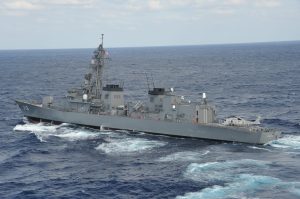The Japanese Maritime Self-Defense Force (JMSDF) destroyer JS Sazanami (DD-113) sailed through the Taiwan Strait between China and Taiwan on September 25, Japanese national lawmakers well versed in national security issues said.
In an epoch-making move, this marked the first time ever for any JMSDF vessel to pass through the Taiwan Strait, one of the world’s most contentious straits in East Asia, since the naval service was established in 1954.
The move came as Prime Minister Kishida Fumio’s administration is striving to strengthen international norms and rules, and to counter China’s growing military assertiveness around Japanese territory, including violating Japan’s airspace.
On September 25, the Sazanami, the fourth of the Takanami-class destroyers, sailed southward from the East China Sea, passed through the Taiwan Strait, and moved out to the South China Sea on the same day.
Australian and New Zealand naval warships also jointly passed through the strait on the same day. The three nations’ navies are scheduled to hold an upcoming exercise in the South China Sea.
It was the first time a New Zealand naval ship had passed through the Taiwan Strait since 2017, according to a statement from New Zealand Defense Minister Judith Collins on September 26. Meanwhile, the last time an Australian naval ship passed through the Taiwan Strait was in November 2023.
Up to now, Japan has refrained from having any JMSDF vessel sail through the strait, mainly because Tokyo has been fearful of retaliation from Beijing.
At the same time, Kishida has always reiterated his government will never tolerate any attempt to change the status quo by force in violation of international law, especially when Tokyo assumed the G-7 presidency and hosted the G-7 Hiroshima Summit in 2023.
As a result, there has been some contradiction between words and actions. For Japan, a nation dependent on trade, protecting sea lanes should be the foundation of the nation. Doesn’t Japan need to both talk the talk and walk the walk proactively, appealing for the freedom of navigation on the high seas based on international law by passing through the Taiwan Strait?
I asked this question directly to Kishida at a press conference on April 8, 2022. “We are neither considering such concrete actions nor planning to do it,” he answered me with a rather cynical smile.
The day before that, I also asked Admiral Sakai Ryo, then newly appointed chief of staff of the JMSDF, about the future possibility of the JMSDF’s first transit through Taiwan Strait. He said, “Our passage of the Taiwan Strait must be perfectly legal because it is an international waterway. But letting JMSDF ships pass through the strait means we will clearly send out some signals. Whether and when and how we will send that signal is not JMSDF’s decision but the government’s political decision.”
Now, two years later, Kishida finally changed his mind. On September 26, Japan’s largest daily, Yomiuri Shimbun, reported, “The Japanese government has been cautious about sending JMSDF vessels through the Taiwan Strait, arguing that military tensions should not be increased. However, Prime Minister Kishida has become increasingly concerned about Japan’s security environment and appears to have decided that such an attitude will not help maintain peace.”
In any case, with its unprecedented move, Japan has now joined the other Western countries engaging in freedom-of-navigation exercises in the Taiwan Strait: The United States, the United Kingdom, France, Canada, the Netherlands, Australia, New Zealand and Germany.
It’s long overdue, but better late than never.
As expected, China’s Defense Ministry strongly opposed the JMSDF’s first passage through the Taiwan Strait.
Ministry spokesman Zhang Xiaogang said at a press conference on September 26, “We firmly oppose provocative acts that undermine China’s sovereignty and security.”
Chinese Foreign Ministry spokesperson Lin Jian also said at a press conference, “The Chinese side is highly wary of the political intentions of Japan’s recent move. We have already lodged a strong protest with the Japanese side.”
He also quoted from the 1972 China-Japan joint statement, which read: “The Japanese government fully understands and respects the Chinese government’s position” that “Taiwan is an inalienable part of the territory of the People’s Republic of China.” Based on that, Lin said, “We urge the Japanese side to abide by its promises, be careful in its words and actions on the Taiwan issue, and not disrupt Sino-Japanese relations or the peace and stability in the Taiwan Strait.”
The security environment surrounding Japan continues to deteriorate. China has been stepping up its military intimidation with incidents such as the violation of Japanese airspace by an intelligence-gathering aircraft in August. A week before the JMSDF’s transit of the Taiwan Strait, a Chinese aircraft carrier came within 24 nautical miles of Japan’s shores for the first time.
Most recently, on September 23, a Russian military aircraft also violated Japanese airspace north of Rebun Island in Hokkaido. The Japan Air Self-Defense Force issued a warning, for the first time using flares that emit strong light and heat.
Many in Tokyo believe that China and Russia are increasing tensions as they are testing Japan’s reaction, taking advantage of the political vacuum following Kishida’s announcement of his resignation. The extremely difficult diplomatic and security challenges will be handed over to the next prime minister, who will be elected in an internal election of the ruling party on September 27.

































